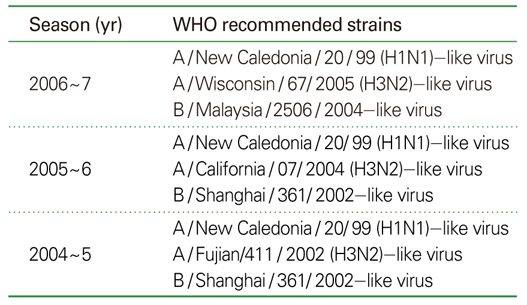 |
 |
- Search
| J Korean Med Assoc > Volume 50(3); 2007 > Article |
Abstract
Influenza vaccination is increasing with the concern of pandemic advance. Worldwide, two types of influenza vaccines are available; inactivated, trivalent, intramuscular vaccine (ITIV) is approved for use among children (≥6 months of age) and adults, while live attenuated intranasal vaccine (LAIV) is indicated for healthy persons 5 to 49 years of age. LAIV has not been used in Korea. In this review, the safety of ITIV is discussed with a particular attention to various subgroups at high risk. In general, local skin reactions are relatively frequent (10~65%), but these are usually self-limiting within 2 days after vaccination. Systemic adverse reactions are very rare compared to local reactions; fever, arthralgia, myalgia, and headache are noted with the incidence less than 15%. The risk of influenza vaccine-related Guillain-Barre syndrome is reported to be lower than that among non-recipients. As for the thimerosal (vaccine preservative), many people have worried about its neurotoxicity, but the benefits from influenza vaccination are considered to outweigh; single-syringe vaccine is recommended only for infants, pregnant women, and persons with thimerosal hypersensitivity. As in healthy persons, ITIV is proven safe in infants, pregnant women, elderly persons, immunocompromised patients, and patients with asthma. ITIV should be avoided in patients with egg allergy; instead, cell-cultured influenza vaccine or antiviral chemoprophylaxis would be recommended.
References
1. Plotkin SA, Orenstein WA. Vaccines. influenza vaccine-inactivated 2004;4th ed. Philadelphia: Saunders Co. 339-370.
2. Wright PF, Thompson J, Vaughn WK, Folland DS, Sell SH, Karzon DT. Trials of influenza A/New Jersey/76 virus vaccine in normal children: an overview of age-related antigenicity and reactogenicity. J Infect Dis 1977;136:S731-S741.
3. Wright PF, Cherry JD, Foy HM, Glezen WP, Hall CB, McIntosh K, Monto AS, Parrott RH, Portnoy B, Taber LH. Antigenicity and reactogenicity of influenza A/USSR/77 virus vaccine in children-a multicentered evaluation of dosage and safety. Rev Infect Dis 1984;5:758-764.
4. Smith NM, Bresee JS, Shay DK, Uyeki TM, Cox NJ, Strikas RA. Advisory Committee on Immunization Practices. Prevention and Control of Influenza: recommendations of the Advisory Committee on Immunization Practices (ACIP). MMWR Recomm Rep 2006;55:1-42.
5. Schonberger LB, Bregman DJ, Sullivan-Bolyai JZ, Keenlyside RA, Ziegler DW, Retailliau HF, Eddins DL, Bryan JA. Guillain-Barré syndrome following vaccination in the National Influenza Immunization Program, United States, 1976~1977. Am J Epidemiol 1979;110:105-123.
6. Lasky T, Terracciano GJ, Magder L, Koski CL, Ballesteros M, Nash D, Clark S, Haber P, Stolley PD, Schonberger LB, Chen RT. The Guillain-Barre syndrome and the 1992~1993 and 1993~1994 influenza vaccines. N Engl J Med 1998;339:1797-1802.
7. From the American Lung Association Asthma Clinical Research Centers. The Safety of Inactivated Influenza Vaccine In Adults and Children With Asthma. N Engl J Med 2001;345:1529-1536.
8. Hambidge SJ, Glanz JM, France EK, McClure D, Xu S, Yamasaki K, Jackson L, Mullooly JP, Zangwill KM, Black SB, Lewis EM, Shinefield HR, Belongia E, Nordin J, Chen RT, Shay DK, Davis RL, DeStefano F. Vaccine Safety Datalink Team. Safety of Trivalent Inactivated Influenza Vaccine in Children 6 to 23 Months Old. JAMA 2006;296:1990-1997.
9. Wright PF. The use of inactivated influenza vaccine in children. Semin Pediatr Infect Dis 2006;17:200-205.
10. Black SB, Shinefield HR, France EK. Effectiveness of influenza vaccine during pregnancy in preventing hospitalizations and outpatient visits for respiratory illness in pregnant women and their infants. Am J Perinatol 2004;21:333-339.
11. Munoz FM, Greisinger AJ, Wehmanen OA. Safety of influenza vaccination during pregnancy. Am J Obstet Gynecol 2006;192:1098-1106.
12. Yeager DP, Toy EC, Baker B. Influenza vaccination in pregnancy. Am J Perinatol 1999;16:283-286.
13. Silverman NS, Greif A. Influenza vaccination during pregnancy. Patients' and Physicians' attitudes. J Reprod Med 2001;46:989-994.
14. Rivetti D, Jefferson T, Thomas R, Rudin M, Rivetti A, Di Pietrantonj C, Demicheli V. Vaccines for preventing influenza in the elderly. Cochrane Database Syst Rev 2006;3:CD008476.
15. Govaert TM, Sprenger MJ, Dinant GJ, Aretz K, Masurel N, Knottnerus JA. Immune response to influenza vaccination of elderly people. A randomized double-blind placebo-controlled trial. Vaccine 1994;12:1185-1189.
16. Margolis KL, Nichol KL, Poland GA, Pluhar RE. Frequency of adverse reactions to influenza vaccine in the elderly. A randomized, placebo-controlled trial. JAMA 1994;1264:1139-1141.
17. Gaeta GB, Stomaiuolo G, Precone DF, Amendola A, Zanetti AR. Immunogenicity and safety of an adjuvanted influenza vaccine in patients with decompensated cirrhosis. Vaccine 2002;20:B33-B35.
18. Kanakoudi-Tsakalidou F, Trachana M, Pratsidou-Gertsi P, Tsitsami E, Kyriazopoulou-Dalaina V. Influenza vaccination in children with chronic rheumatic diseases and long-term immunosuppressive therapy. Clin Exp Rheumatol 2001;19:589-594.
19. Zanetti AR, Amendola A, Besana S, Boschini A, Tanzi E. Safety and immunogenicity of influenza vaccination in individuals infected with HIV. Vaccine 2002;20:B29-B32.
20. Audicana MT, Munoz D, del Pozo MD. Alergic contact dermatitis from mercury antiseptics and derivatives: study protocol of tolerance to intramuscular injections of thimerosal. Am J Contact Dermat 2002;13:3-9.
- TOOLS
-
METRICS

-
- 3 Crossref
- Scopus
- 1,164 View
- 7 Download
-
Related articles in
J Korean Med Assoc -
Influenze Virus1998 March;41(3)







